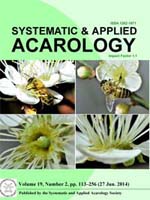Neocypholaelaps indica Evans, 1963 is the resident of flowers. It is one of the twenty known species of the genus Neocypholaelaps (De Moraes & Narita 2010). This species was found on more than thirty four kinds of flowers and also on the visitors of the flowers, such as bees, butterflies and flies. Four species of honey bees, Apis cerana, A. dorsata, A. florea and A. mellifera are known in association with this mite species (Eickwort 1988).
Evans (1963) originally described this species from Apis cerana in India. It is now distributed in Asia, North Africa and East Europe: China (Mainland: Teng & Pan 1964; Taiwan Island: Lo & Chao 1975), Egypt (Senna 1997), Korea (Woo & Lee 1993), Nepal (Baker & Delfinado 1976), Pakistan (Shafi 1986), Sri Lanka (Koeniger et al. 1983) and Russia (Grobov 1974).
Neocypholaelaps indica completes its life cycle in flowers. Pollen is the main nutrition source for them and nectar may also be used to survive. Usually all life stages, egg, larva, protonymph, deutonymph and adult, are present in a flower (Cover photo, bottom left and right). The adult females disperse with the aid of bees and other flower visitors (Cover photo, top left and right). They are often seen in bee hives in very large numbers in flowering seasons. We collected female mites from both European bee Apis mellifera (Plate 1. left) and Asian bee A. cerana (Plate 1. right) in mid-April in Fuzhou, China. Seventy females were counted from a single Asian bee and one to a dozen of females were found in pollen granules collected by bees.







